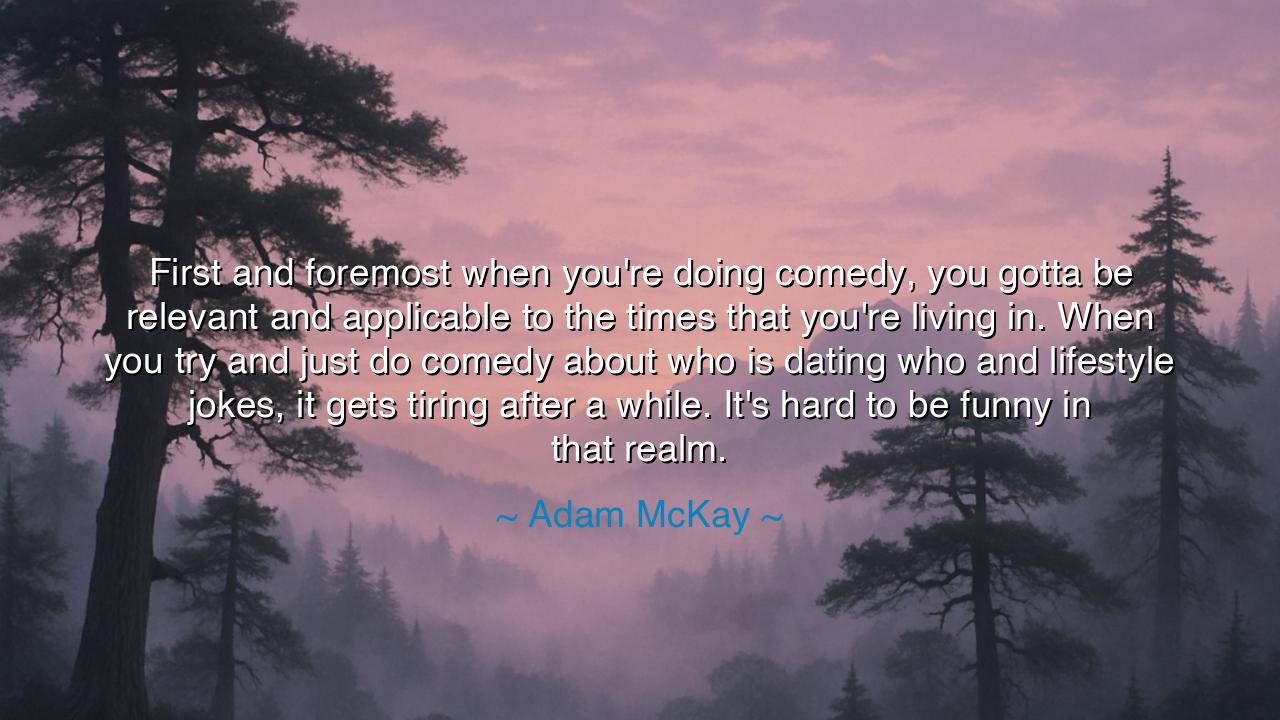
First and foremost when you're doing comedy, you gotta be
First and foremost when you're doing comedy, you gotta be relevant and applicable to the times that you're living in. When you try and just do comedy about who is dating who and lifestyle jokes, it gets tiring after a while. It's hard to be funny in that realm.






In the marketplaces of laughter, where jesters trade in glances and breath, a maker of mirth lays down a stern rule: “First and foremost when you’re doing comedy, you gotta be relevant and applicable to the times that you’re living in. When you try and just do comedy about who is dating who and lifestyle jokes, it gets tiring after a while. It’s hard to be funny in that realm.” Hear the hammer on the anvil—comedy as a craft with weight and heat, not merely a necklace of quips. The saying reminds us that jokes are not decorations; they are tools that cut, open, and repair. If they do not meet the times, they dull. If they hide from what is burning outside the tent, the tent becomes a coffin.
The ancients taught that festivals were not only for delight; they were for diagnosis. A chorus could sing the city back to its senses. Thus the demand to be relevant and applicable is not fashion-chasing; it is covenant-keeping with the audience’s real weather. Our seasons bring debt and drought, rumor and rage, small mercies and great risks. To step onstage and speak only of who is dating whom—of handbags, brunches, and curated habits—is to offer a reed flute when the house needs a bell. Lifestyle jokes may sparkle, but they evaporate; they do not bind strangers into a commons or name the ache that everyone carries in the dark.
Consider Aristophanes, priest of the Attic laugh. In Lysistrata he did not merely toss gossip; he reached into war’s furnace and forged a farce that mocked the machinery of endless conflict. The times were raw, and so was the joke—and therefore it lives. The audience did not leave with a tally of celebrity couplings; they left with a mirror. In every age, the comedic work that stays is the work that dares to press its ear to the city’s chest and keep time with its heartbeat.
Or look to Charlie Chaplin as the world slid toward catastrophe. He risked the sacred rule of silence to speak in The Great Dictator, turning a clown’s tenderness into a trumpet against cruelty. That speech is not a lifestyle joke; it is a lantern. The hat, the cane, the stumble remained, but they were yoked to the times—and so the comedy became a bridge from terror to courage. This is the lineage behind the saying: humor that faces reality can heal; humor that dodges reality can only distract, and soon wearies even itself.
Why do the small, glossy jokes tire us? Because the human appetite is larger than novelty. We hunger for orientation, not only entertainment. A set filled with dating rumors and cocktail quirks treats the crowd like a room of appetites; a set that grapples with the times treats the crowd like a people. The first flatters; the second dignifies. And dignity has a longer shelf life than delight. To be truly funny is not to avoid the hard thing; it is to make room for breath while we face it.
Yet the counsel is not a ban on lightness. The master jester smuggles relief into the burning building, but carries a map as well. Applicable jokes find the hinge where laughter opens a stuck door—bureaucracy seen in a single absurd form, greed reduced to a child’s game, fear unmasked by an image so precise that the room exhales together. In such moments, we are not merely amused; we are reassembled.
Therefore, pass down this teaching like a kit for apprentices: Make your comedy answer the times. Begin each piece with a question—what is really happening to these people right now?—and let your craft braid wit to witness. Keep one pocket for ephemera (yes, a lifestyle bit can rinse the palate), but keep your main tools sharp for the work that matters. Seek a subject where laughter can lift weight rather than avoid it. Test every line: Is it merely clever, or is it also applicable?
Practical steps for makers of mirth: (1) Keep a “ledger of the day”—three real frictions from the week (a bill, a headline, a subway moment) and draft a joke that reveals their hinge. (2) Balance your set: 20% sparkle, 80% substance tethered to the times. (3) Replace gossip with pattern: rather than “who is dating whom,” ask what the gossip reveals about status, loneliness, or performance—weave up, not sideways. (4) Field-test your bit with a question to the room—if heads nod before they laugh, you’re close to the bone. (5) Aim for afterglow: the best funny leaves a thought glowing when the laugh is gone. In this way, your jokes will not merely pass the hour; they will companion the age, and your audience will leave lighter, truer, and more awake.






AAdministratorAdministrator
Welcome, honored guests. Please leave a comment, we will respond soon